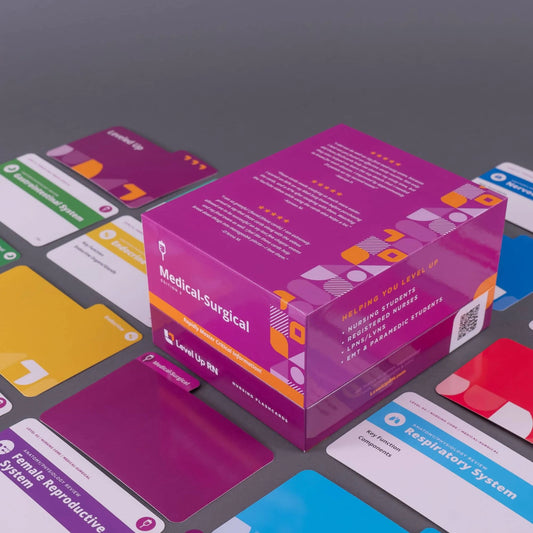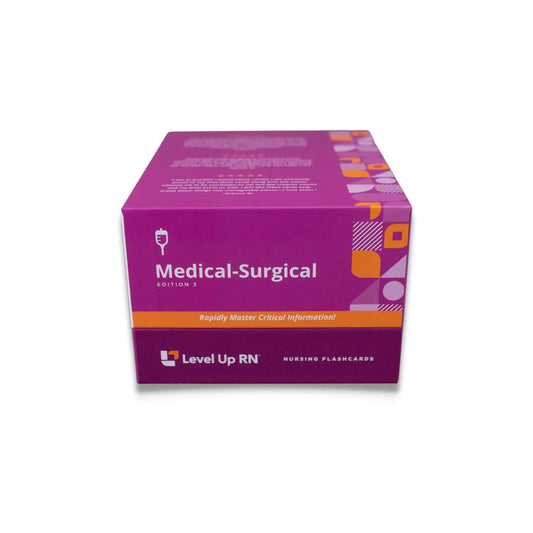Med-Surg - Nervous System, part 12: Stroke/Cerebrovascular Accident
Updated: Cathy ParkesA stroke or cerebrovascular accident (CVA). The pathophysiology, risk factors, signs/symptoms (including left vs. Right-sided stroke symptoms), diagnosis, treatment of a stroke. Nursing care for a patient with a stroke.
Full Transcript: Med-Surg - Nervous System, part 12: Stroke/Cerebrovascular Accident
Full Transcript: Med-Surg - Nervous System, part 12: Stroke/Cerebrovascular Accident
Hi, I'm Cathy with Level Up RN. In this video, we are going to talk about a stroke or cerebrovascular accident. At the end of the video, I'm going to give you guys a little quiz, a little knowledge check to test your understanding of some of the key points I'll be making in this video. So definitely stay tuned for that. And as always, if you have our medical surgical nursing flashcards definitely pull those out so you can follow along with me.
With a stroke, we have the sudden interruption of blood flow to the brain and this deprives the brain of the oxygen and the nutrients that it needs. And this leads to brain tissue damage and necrosis. So we have hemorrhagic strokes and ischemic strokes.
With a hemorrhagic stroke, we have a ruptured artery or aneurysm in the brain.
Ischemic strokes are caused by a blood clot. So we have a thrombotic stroke, which is where we have a blood clot in the cerebral artery, or we have an embolic stroke, which is where a blood clot from another part of the body travels up and blocks the cerebral artery.
So this could be caused by a DVT, for example.
Risk factors associated with a stroke include smoking, hypertension, diabetes, A-fib, hyperlipidemia, and a previous TIA, which is a transient ischemic attack.
So with a TIA, there is the temporary blockage of blood flow to the brain, and if a patient has had a TIA, it places them at much higher risk for having a stroke in the future.
Symptoms of a stroke include unilateral limb weakness. So sudden weakness of the arm or leg on one side. It can also cause facial drooping, slurred speech, dizziness, as well as visual disturbances. If the patient has a stroke on the left side of the brain, that can cause something called expressive aphasia. This means that the patient will have the inability to speak or understand language. They may also have difficulty with reading and writing.
So our little cool chicken hint here on the card is left equals language. So if you have a stroke on the left side, that can definitely impact the patient's language abilities. In addition, if the patient had that stroke on the left side, that can cause right-sided weakness or paralysis. So if you watched my AMP review of the nervous system, you know that the left side of the brain controls movement on the right side of the body. So that's why with a left-sided stroke, we have that paralysis or weakness on the right side of the body. If the patient had a stroke on the right side of the brain, that can cause poor judgment and impulse control, it can cause the patient to overestimate their abilities as well.
So our little cool chicken hint here is that right equals reckless, which means that the patient will have poor judgment if they have that right-sided stroke. In addition, with a right-sided stroke, we are going to have left- sided weakness or paralysis because the right side of the brain controls movement on the left side of the body.
Diagnosis of a stroke includes the use of a CT, an MRI, or a cerebral angiogram.
In terms of treatment, if the patient had an ischemic stroke, then we could use thrombolytic agents such as Alteplase. However, we want to make sure we administer these thrombolytic agents within three hours of the onset of symptoms, and that's important to remember. Other medications for an ischemia stroke include anticoagulants as well as antiplatelets.
If the patient had a hemorrhagic stroke, then we would administer antihypertensive agents to try to bring that blood pressure down and prevent any more blood loss or minimize blood loss, at least.
In terms of nursing care, we're going to want to implement fall precautions because the patient will likely have paralysis or paralysis on one side of their body. We want to assess their swallowing ability and their gag reflex before letting them eat or drink anything. So if the patient has dysphagia, they may require thickened liquids. And if they have dysphagia, we want to advise them to chuck-- tuck not chuck. Tuck their chin against their chest to help facilitate swallowing. We also need to reposition our patients frequently in order to prevent pressure injuries.
And then if our patient has something called homonymous hemianopsia, which means that they only see on one side of their visual field, then we need to advise them to use what's called a scanning technique. So they would need to scan the whole visual field in order to see everything, because if they don't scan, they're just seeing one side of that visual field.
All right. Time for a quiz. I have three questions. First question, a temporary blockage of blood flow to the brain is called a blank. The answer is a TIA or transient ischemic attack. Question number two, a stroke on the left side of the brain can cause expressive aphasia. True or false? The answer is true. So remember, left side language. Okay, question number three, for an ischemic stroke, thrombolytics should be administered within blank hours of symptoms. The answer is three. So they need to be administered within three hours of symptoms.
Okay, that's it. I hope you enjoyed this video and I hope it was helpful. If so, make sure to like it and leave me a comment. Take care.


